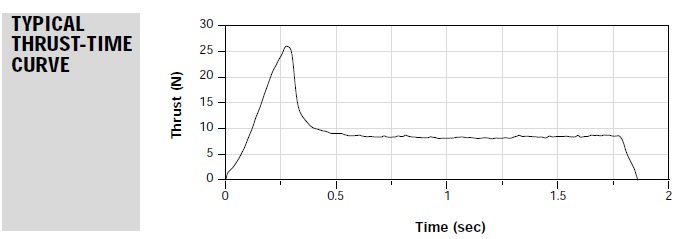RGClark
Mathematician
Can't find much on the specs of black powder rockets made by amateurs. After a web search, I gather black powder motors have a combustion chamber pressure in the range of just 100 PSI. Correct? This would explain why they commonly use just paper or cardboard casings. But in strength to weight terms this is much weaker than using an aluminum or carbon fiber casing.
If you look at the specs of higher performance APCP motors, such as by Cesaroni, their combustion chamber pressures are in the range of 500 PSI, and their mass ratios using aluminum casings are about 2.5 to 1. Since mass ratio is (dry mass + propellant mass)/(dry mass) = 1 + (propellant mass)/(dry mass), this means their propellant to dry mass ratio is 1.5 to 1. But the required thickness of the casing walls is proportional to the chamber pressure. But if the chamber pressure with black powder propellant is 1/5th as large, that means the wall thickness can be 1/5th as much and the casing weight will be 1/5th as much. Since black powder propellant and APCP have similar densities at around 1.7 g/cc, this means the propellant to dry mass ratio for the black powder using aluminum casing will be 5*1.5 = 7.5 to 1, and the mass ratio will be 8.5 to 1.
Even more, since carbon fiber is about twice as strong per weight as aluminum, meaning the casing could weigh half as much, a carbon fiber black powder casing would get a propellant to dry mass ratio of 15 to 1, for a mass ratio of 16 to 1. These are very high mass ratios for solid rocket motors. For instance with a 90 s Isp, or about 900 m/s exhaust velocity, common for black powder motors, a bare stage with aluminum casing could get a delta-v of 900*ln(8.5) = 1,920 m/s. And with a carbon fiber casing it could get 900*ln(16) = 2,500 m/s.
But this gets really interesting when you look at the Isp possible for black powder motors with vacuum-optimized nozzles, say for upper stage use. According to rocket engine performance software such as Propep or RPA, black powder motors can get a vacuum-optimized Isp of 158 s, about 1,580 m/s exhaust velocity. Then the aluminum casing would give a delta-v of 1,580*ln(8.5) = 3,380 m/s. And the carbon-fiber casing would give a delta-v of 1,580*ln(16) = 4,380 m/s.
Now these are quite high delta-v's of the size commonly attained by orbital stages. So the conclusion is IF the combustion pressure of black powder rockets really is only 100 psi, then giving them lightweight aluminum or carbon fiber casings and vacuum-optimized nozzles means black powder motors could be used for orbital stages.
Bob Clark
If you look at the specs of higher performance APCP motors, such as by Cesaroni, their combustion chamber pressures are in the range of 500 PSI, and their mass ratios using aluminum casings are about 2.5 to 1. Since mass ratio is (dry mass + propellant mass)/(dry mass) = 1 + (propellant mass)/(dry mass), this means their propellant to dry mass ratio is 1.5 to 1. But the required thickness of the casing walls is proportional to the chamber pressure. But if the chamber pressure with black powder propellant is 1/5th as large, that means the wall thickness can be 1/5th as much and the casing weight will be 1/5th as much. Since black powder propellant and APCP have similar densities at around 1.7 g/cc, this means the propellant to dry mass ratio for the black powder using aluminum casing will be 5*1.5 = 7.5 to 1, and the mass ratio will be 8.5 to 1.
Even more, since carbon fiber is about twice as strong per weight as aluminum, meaning the casing could weigh half as much, a carbon fiber black powder casing would get a propellant to dry mass ratio of 15 to 1, for a mass ratio of 16 to 1. These are very high mass ratios for solid rocket motors. For instance with a 90 s Isp, or about 900 m/s exhaust velocity, common for black powder motors, a bare stage with aluminum casing could get a delta-v of 900*ln(8.5) = 1,920 m/s. And with a carbon fiber casing it could get 900*ln(16) = 2,500 m/s.
But this gets really interesting when you look at the Isp possible for black powder motors with vacuum-optimized nozzles, say for upper stage use. According to rocket engine performance software such as Propep or RPA, black powder motors can get a vacuum-optimized Isp of 158 s, about 1,580 m/s exhaust velocity. Then the aluminum casing would give a delta-v of 1,580*ln(8.5) = 3,380 m/s. And the carbon-fiber casing would give a delta-v of 1,580*ln(16) = 4,380 m/s.
Now these are quite high delta-v's of the size commonly attained by orbital stages. So the conclusion is IF the combustion pressure of black powder rockets really is only 100 psi, then giving them lightweight aluminum or carbon fiber casings and vacuum-optimized nozzles means black powder motors could be used for orbital stages.
Bob Clark





